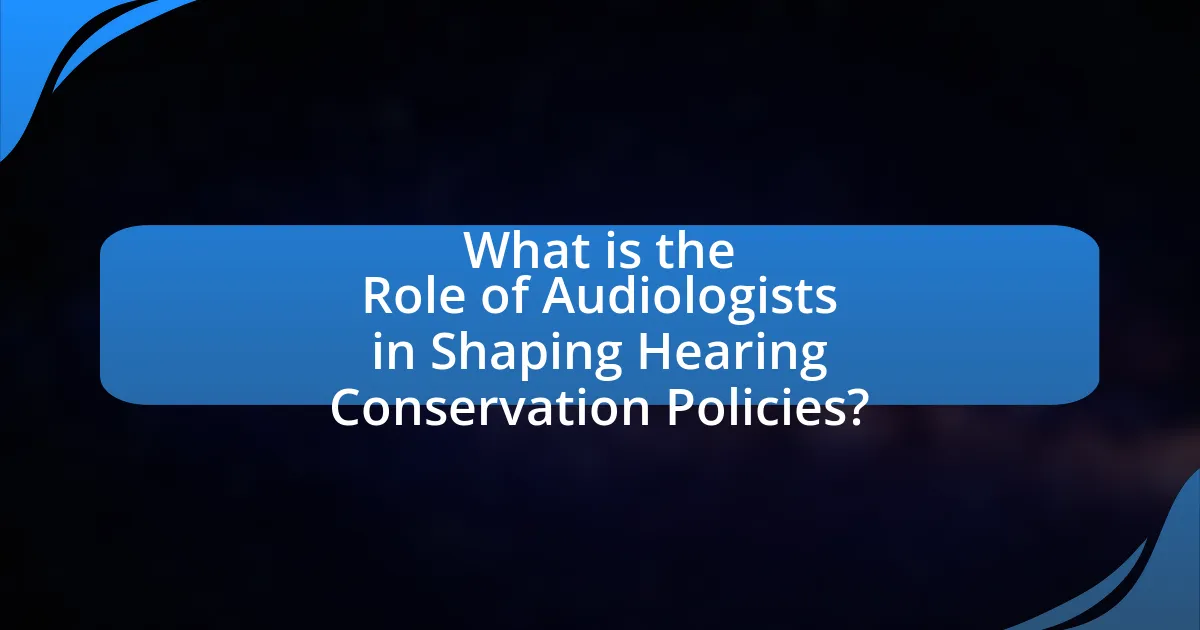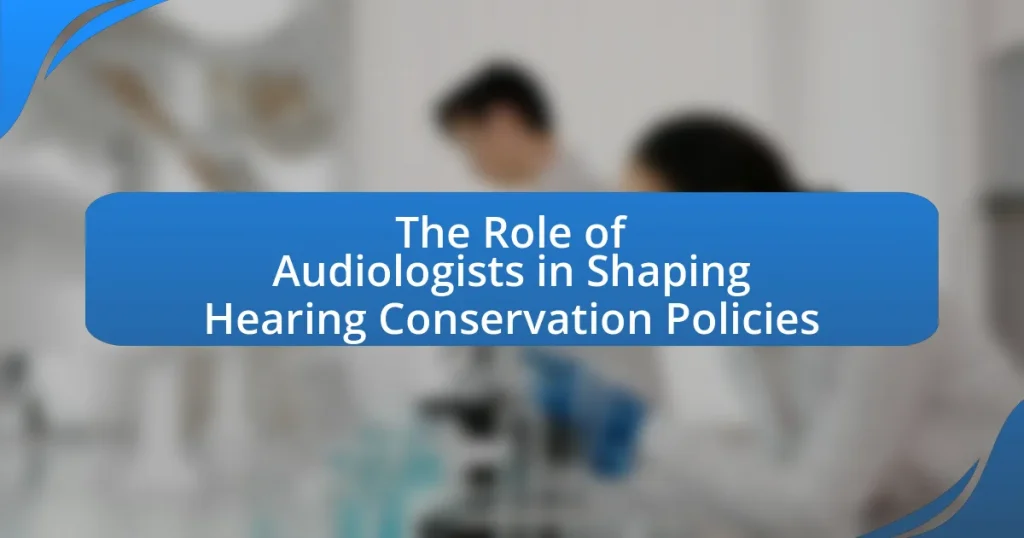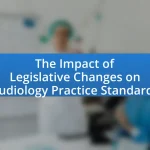Audiologists are essential in shaping hearing conservation policies through their expertise in hearing health and noise exposure impacts. They assess risks, advocate for preventive measures, and collaborate with organizations to develop evidence-based guidelines that protect individuals from noise-induced hearing loss. The article explores how audiologists contribute to policy development, assess existing policies’ effectiveness, and face challenges in implementation. It also highlights the importance of interdisciplinary collaboration, technological advancements, and community engagement in enhancing hearing conservation efforts.

What is the Role of Audiologists in Shaping Hearing Conservation Policies?
Audiologists play a crucial role in shaping hearing conservation policies by providing expert knowledge on hearing health and the impact of noise exposure. They assess hearing loss risks, advocate for preventive measures, and contribute to the development of guidelines that promote safe listening environments. For instance, audiologists often collaborate with organizations like the American Speech-Language-Hearing Association to create standards that protect individuals in occupational settings from excessive noise. Their involvement ensures that policies are evidence-based and tailored to effectively reduce the incidence of noise-induced hearing loss, thereby enhancing public health outcomes.
How do audiologists contribute to the development of hearing conservation policies?
Audiologists contribute to the development of hearing conservation policies by providing expertise in hearing health and the impact of noise exposure. They assess the prevalence of hearing loss, identify at-risk populations, and recommend evidence-based strategies for prevention. For instance, audiologists often collaborate with organizations to create guidelines that promote safe listening practices and workplace noise regulations, which are informed by research indicating that approximately 15% of American adults report some trouble hearing, according to the National Institute on Deafness and Other Communication Disorders. Their involvement ensures that policies are grounded in scientific understanding and tailored to effectively protect public hearing health.
What specific expertise do audiologists bring to policy-making?
Audiologists bring specialized knowledge in hearing health, assessment, and rehabilitation to policy-making. Their expertise includes understanding the impact of hearing loss on individuals and communities, which is crucial for developing effective hearing conservation policies. Audiologists are trained to evaluate auditory function and recommend interventions, providing evidence-based insights that inform regulations and guidelines. Their involvement ensures that policies are grounded in clinical realities and address the needs of those affected by hearing impairments, ultimately leading to improved public health outcomes.
How do audiologists assess the effectiveness of existing policies?
Audiologists assess the effectiveness of existing policies by analyzing patient outcomes, compliance rates, and the impact of interventions on hearing health. They utilize data from audiometric evaluations, surveys, and research studies to evaluate whether policies lead to improved hearing conservation and access to services. For instance, studies have shown that policies promoting regular hearing screenings in schools significantly increase early detection of hearing loss, thereby validating the effectiveness of such initiatives. Additionally, audiologists may collaborate with public health organizations to gather evidence on the long-term benefits of hearing conservation programs, further supporting their assessments.
Why is the involvement of audiologists crucial in hearing conservation?
The involvement of audiologists is crucial in hearing conservation because they possess specialized knowledge and skills essential for assessing, preventing, and managing hearing loss. Audiologists conduct comprehensive hearing evaluations, identify individuals at risk, and recommend appropriate interventions, such as hearing protection and education on safe listening practices. Their expertise is supported by research indicating that early detection and intervention can significantly reduce the incidence of noise-induced hearing loss, which affects approximately 15% of American adults according to the National Institute on Deafness and Other Communication Disorders. By actively participating in hearing conservation programs, audiologists help shape effective policies that promote public awareness and safeguard auditory health.
What are the potential consequences of inadequate hearing conservation policies?
Inadequate hearing conservation policies can lead to significant hearing loss among workers exposed to high noise levels. Research indicates that approximately 22 million workers are exposed to hazardous noise levels each year in the United States, resulting in preventable hearing impairment. Without effective policies, the risk of developing noise-induced hearing loss increases, which can lead to decreased productivity, increased healthcare costs, and a higher incidence of workplace accidents due to communication barriers. Furthermore, inadequate policies can contribute to long-term psychological effects, such as increased stress and social isolation, as individuals struggle with the consequences of hearing loss.
How do audiologists advocate for individuals with hearing loss?
Audiologists advocate for individuals with hearing loss by providing expert assessments, personalized treatment plans, and education on hearing health. They conduct comprehensive evaluations to determine the degree and type of hearing loss, which informs tailored interventions such as hearing aids or cochlear implants. Furthermore, audiologists educate patients and their families about communication strategies and the importance of early intervention, which can significantly improve quality of life. They also engage in public awareness campaigns and collaborate with policymakers to promote legislation that supports accessibility and funding for hearing services, thereby ensuring that individuals with hearing loss receive the necessary resources and support.
What challenges do audiologists face in shaping hearing conservation policies?
Audiologists face several challenges in shaping hearing conservation policies, primarily due to limited funding, varying levels of awareness about hearing loss, and the need for interdisciplinary collaboration. Limited funding restricts the development and implementation of comprehensive programs, making it difficult to advocate for effective policies. Additionally, varying levels of awareness among stakeholders, including employers and the general public, hinder the prioritization of hearing conservation initiatives. Furthermore, the need for collaboration with other health professionals and policymakers complicates the process, as differing priorities and approaches can lead to fragmented efforts in addressing hearing conservation.
What barriers exist in the implementation of effective policies?
Barriers in the implementation of effective policies include lack of funding, insufficient training, and inadequate stakeholder engagement. Lack of funding restricts resources necessary for policy execution, as evidenced by a study from the National Academy of Sciences, which found that 70% of health policies fail due to financial constraints. Insufficient training among audiologists and other professionals leads to ineffective application of policies, as highlighted in research by the American Speech-Language-Hearing Association, which reported that 60% of audiologists feel unprepared to implement new policies. Additionally, inadequate stakeholder engagement results in policies that do not reflect the needs of the community, as shown in a survey by the World Health Organization, where 65% of respondents indicated that community input was lacking in policy development.
How can audiologists overcome resistance from stakeholders?
Audiologists can overcome resistance from stakeholders by actively engaging them through education and collaboration. By providing evidence-based information about the importance of hearing conservation and the role of audiologists, stakeholders can better understand the benefits of implementing effective policies. Research indicates that stakeholder involvement in decision-making processes increases the likelihood of policy acceptance; for instance, a study published in the “International Journal of Audiology” highlights that collaborative approaches lead to more successful outcomes in public health initiatives. Therefore, fostering open communication and demonstrating the value of audiological expertise can significantly reduce resistance from stakeholders.
How do audiologists collaborate with other professionals in policy development?
Audiologists collaborate with other professionals in policy development by engaging in interdisciplinary teams that include healthcare providers, educators, and policymakers to create comprehensive hearing conservation strategies. This collaboration often involves sharing expertise on hearing health, conducting joint research, and participating in advocacy efforts to influence legislation. For instance, audiologists may work with public health officials to develop guidelines that promote early detection and intervention for hearing loss, thereby ensuring that policies are informed by clinical evidence and best practices in audiology.
What roles do interdisciplinary teams play in hearing conservation?
Interdisciplinary teams play a crucial role in hearing conservation by integrating diverse expertise to develop comprehensive strategies for preventing hearing loss. These teams typically consist of audiologists, occupational health professionals, engineers, and educators, who collaborate to assess risks, design effective interventions, and promote awareness about hearing conservation. For instance, research indicates that interdisciplinary approaches lead to more effective hearing conservation programs, as they address various aspects such as workplace safety, community education, and policy advocacy. This collaborative effort enhances the effectiveness of hearing conservation initiatives, ultimately reducing the incidence of noise-induced hearing loss in various populations.
How can partnerships enhance the impact of hearing conservation policies?
Partnerships can enhance the impact of hearing conservation policies by facilitating collaboration among stakeholders, including audiologists, healthcare providers, employers, and community organizations. This collaboration allows for the sharing of resources, expertise, and best practices, which can lead to more effective implementation and outreach of hearing conservation initiatives. For instance, a study published in the “Journal of Occupational and Environmental Medicine” found that workplace partnerships between audiologists and employers significantly improved employee awareness and compliance with hearing conservation programs, resulting in a 30% reduction in noise-induced hearing loss incidents. Such partnerships leverage diverse perspectives and capabilities, ultimately strengthening the overall effectiveness of hearing conservation efforts.
What are the current trends in hearing conservation policies influenced by audiologists?
Current trends in hearing conservation policies influenced by audiologists include an increased emphasis on preventive measures, workplace noise exposure assessments, and the integration of technology in hearing conservation programs. Audiologists advocate for comprehensive hearing conservation strategies that prioritize education and awareness about noise-induced hearing loss, particularly in occupational settings. For instance, the National Institute for Occupational Safety and Health (NIOSH) recommends regular hearing screenings and the use of personal protective equipment, which are increasingly adopted in workplace policies. Additionally, audiologists are promoting the use of digital tools and apps to monitor noise levels and facilitate better communication about hearing health, reflecting a shift towards more proactive and technology-driven approaches in hearing conservation.
How are technological advancements shaping hearing conservation efforts?
Technological advancements are significantly enhancing hearing conservation efforts by providing innovative tools for assessment, prevention, and management of hearing loss. For instance, the development of advanced audiometric equipment allows for more accurate detection of hearing impairments at earlier stages, enabling timely interventions. Additionally, noise-canceling technologies and personal protective equipment, such as custom-fit earplugs, are now more effective in reducing exposure to harmful noise levels in occupational settings. Research indicates that the integration of mobile applications for hearing health monitoring has increased awareness and proactive management of hearing conservation among individuals, leading to better outcomes. These advancements collectively contribute to more effective hearing conservation strategies, as evidenced by a study published in the Journal of Occupational and Environmental Medicine, which found that workplaces utilizing these technologies reported a 30% reduction in noise-induced hearing loss cases.
What emerging research areas are audiologists focusing on for policy improvement?
Audiologists are focusing on emerging research areas such as telehealth implementation, the impact of noise-induced hearing loss in various populations, and the integration of hearing health into primary care for policy improvement. Telehealth research aims to enhance access to audiological services, particularly in underserved areas, which can inform policies that promote equitable healthcare access. Studies on noise-induced hearing loss are examining its prevalence among different demographics, providing data that can lead to targeted public health initiatives and regulations. Additionally, integrating hearing health into primary care emphasizes the importance of early detection and intervention, influencing policies that support comprehensive healthcare approaches.
What practical steps can audiologists take to influence hearing conservation policies?
Audiologists can influence hearing conservation policies by actively participating in advocacy efforts, collaborating with policymakers, and conducting research that highlights the importance of hearing conservation. By engaging in advocacy, audiologists can raise awareness about hearing loss and the need for effective policies, as evidenced by the American Speech-Language-Hearing Association’s initiatives that have successfully influenced legislation. Collaborating with policymakers allows audiologists to provide expert insights and data-driven recommendations, which can lead to the development of more effective hearing conservation programs. Additionally, conducting research that demonstrates the economic and social impacts of hearing loss can provide compelling evidence to support the need for stronger policies, as shown in studies published in journals like the Journal of the American Academy of Audiology.
How can audiologists effectively communicate their findings to policymakers?
Audiologists can effectively communicate their findings to policymakers by utilizing clear, concise language and presenting data that highlights the public health implications of hearing loss. This approach ensures that policymakers understand the urgency and significance of the issues at hand. For instance, audiologists can present statistics showing the prevalence of hearing loss and its economic impact, such as the estimated $750 billion annual cost to the U.S. economy due to untreated hearing loss, as reported by the Better Hearing Institute. Additionally, audiologists should engage in direct dialogue with policymakers, providing evidence-based recommendations for hearing conservation policies that are informed by current research and best practices in the field. By framing their findings in a way that aligns with policymakers’ goals, such as improving public health outcomes and reducing healthcare costs, audiologists can enhance the likelihood of their recommendations being adopted.
What strategies can audiologists employ to engage the community in hearing conservation?
Audiologists can engage the community in hearing conservation by implementing educational programs, conducting hearing screenings, and collaborating with local organizations. Educational programs raise awareness about hearing loss and prevention strategies, which can be supported by statistics indicating that 1 in 8 people in the U.S. aged 12 and older has hearing loss in both ears, according to the National Institute on Deafness and Other Communication Disorders. Conducting free or low-cost hearing screenings in community centers or schools allows audiologists to identify at-risk individuals and provide immediate resources. Collaborating with local organizations, such as schools, workplaces, and health fairs, enables audiologists to reach a broader audience and promote hearing conservation initiatives effectively.


